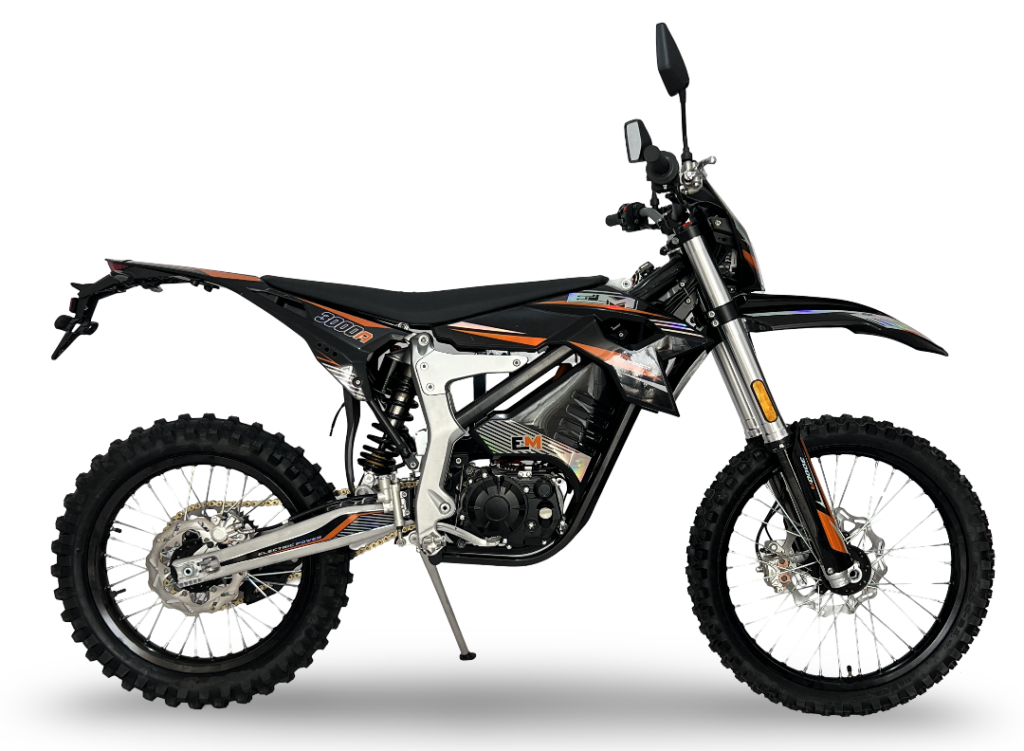In the world of extreme off-road motorcycle racing, performance, reliability, and versatility are paramount. Two of the most popular and highly sought-after models in this category are the gas-powered enduro dirt bikes and electric enduro dirt bikes. While both offer unique advantages, they cater to different riding styles and preferences. Understanding the key differences between these two types of motorcycles can help you make an informed decision based on your riding style, budget, and long-term usage.
1. Powertrain and Performance
One of the most significant differences between gas-powered and electric enduro dirt bikes lies in their powertrain systems. Gas-powered motorcycles rely on combustion engines, which provide a wide range of power output depending on the fuel mixture and RPM. Electric motorcycles, on the other hand, use batteries and electric motors to generate power.
- Gas-Powered: Gas engines are known for delivering high torque at lower RPMs, making them ideal for handling rough terrain and providing strong acceleration. They also offer a smoother and more consistent power delivery compared to electric motors.
- Electric: Electric motorcycles provide instant torque and a wide range of power output depending on the voltage level. They are particularly well-suited for riders who prefer lightweight, nimble machines that excel in technical sections.
2. Battery Life and Charging
Electric enduro dirt bikes rely entirely on battery power, which means their performance is directly tied to the condition, capacity, and lifespan of their batteries. Gas-powered motorcycles do not have this issue since they depend solely on fuel.
- Gas-Powered: Since they run on gasoline, gas-powered motorcycles are only powered when fuel is available. This can be a limitation in areas with limited access to fuel stations or off-road courses where fuel availability may be an issue.
- Electric: Electric motorcycles require regular charging from a power source, typically a portable charger or a plugged-in charging unit. The battery life depends on the rider’s riding style, including how often they stop and start, as well as terrain conditions.
3. Cost and Maintenance
The cost and maintenance requirements of gas-powered and electric enduro dirt bikes differ significantly, primarily due to their powertrain systems.
- Gas-Powered: Gas-powered motorcycles typically come with higher upfront costs compared to electric models. Additionally, they require regular fuel refills, which can be a significant expense depending on fuel prices and usage frequency.
- Electric: Electric motorcycles are generally more budget-friendly in the long term due to their reliance on electricity rather than fuel. However, they do require maintenance for their batteries, components, and other electrical systems. Proper care can extend the lifespan of these components.
4. Environmental Impact
From a sustainability perspective, electric enduro dirt bikes present a more eco-friendly option compared to gas-powered models. Electric vehicles reduce greenhouse gas emissions significantly by eliminating combustion processes that produce carbon dioxide.
- Gas-Powered: Gas-powered motorcycles contribute to air pollution and greenhouse gas emissions due to the combustion of gasoline.
- Electric: Electric motorcycles, especially those with advanced battery technology, have a much lower environmental impact compared to their gas-powered counterparts. They align with modern sustainability trends and are ideal for riders concerned about their carbon footprint.
5. Durability and Off-Road Performance
Both gas-powered and electric enduro dirt bikes are designed for extreme off-road conditions, but they differ in terms of durability and performance characteristics.
- Gas-Powered: Gas engines are known for their durability and reliability, especially when well-maintained. They can handle rough and unpredictable terrain with ease due to their high torque and power output.
- Electric: Electric motorcycles offer modern engineering solutions that enhance durability and longevity. Advanced battery management systems and motor designs make electric bikes more resilient to the challenges of off-road conditions.
Conclusion
Choosing between a gas-powered enduro dirt bike and an electric enduro dirt bike depends on your riding style, preferences, budget, and long-term usage. If you value traditional powertrain technology, have limited access to fuel stations, or prefer higher torque for technical sections, a gas-powered model may be the better choice. On the other hand, if you prioritize environmental sustainability, want instant power, or prefer a lightweight, nimble machine, an electric enduro dirt bike might be more suitable.
As technology continues to evolve, both types of motorcycles are likely to see improvements in their respective areas. Whether it’s fuel efficiency advancements for gas-powered bikes or battery innovation for electric models, staying informed about the latest developments can help you make a decision that aligns with your riding lifestyle and goals.



